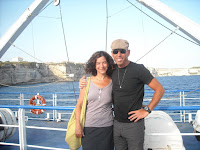
“A gem cannot be polished without friction, nor a man perfected without trials”
- Chinese Proverb
We arrived late in Santa Teresa di Gallura, a port city in northeastern Sardinia and booked a room at the first hotel we could find. From our tiny balcony, we had a view of the parking lot; but beyond that, we had a glimpse of the turquoise blue Sardinian sea. We strolled the “centro”, chocked full of touristy trinkets, t-shirt shops and gelaterias, then ate an over-priced dinner and went straight to bed. The next morning, surprisingly awake at 6am, I slipped on sandals and a dress, and went for a walk. Following a path to the castle (yes, castle) I took a detour down a side trail to the ocean. Down a steep stone staircase, past a cactus grove, then a dirt path and finally reaching the huge rocks next to the sea, I sat next to the softly breaking waves and watched the sun rising over the clear, aquamarine water.
I realized at that moment that I hadn’t spent a single minute alone next to the ocean in Italy. Sure, I’ve been alone without my husband and daughter, but never once, in Liguria, was I alone at the ocean—there were always other people around. Liguria, while lovely, doesn’t exactly have much ‘wild’ coastline and it’s virtually impossible to find any privacy. I could see already that Sardinia was going to be different, and I was very very happy. Maybe it’s the native Oregonian in me, but I like a little privacy with my nature.
The morning was sunny and bright, and we ate a quick breakfast, crammed all our suitcases and paraphernalia into our tiny car and hit the road, refreshed and ready to find our ideal town on the island of Sardinia. We drove slightly inland to Sassari, the only really large city in northern Sardinia, to buy some essentials we couldn’t find elsewhere:
1) a guide book on Sardinia in English (we were flying blind)
2) reading glasses, to replace my broken ones
3) bicycle lock
4) a very important red/white diagonally-striped sign that we’ve learned is legally required when hauling anything that extends off the back of a vehicle (i.e., the bike rack with Jeff’s bicycle). The sign must be affixed to the “extension”, presumably to alert other drivers that they can still tailgate, just a few inches back.
Sassari is a busy, noisy authentic working city with a serious, no-nonsense feel. Its central core is marvelously efficient, and we were able to find everything we needed in less than an hour and were back on the road again.
We drove to Alghero, an attractive, large town on the northwest coast of Sardinia, where we’d heard (from my niece Annie) we could rent affordable “villinis” at a camping area called La Mariposa. We were excited to have a destination. I’d been emailing La Mariposa for a week, trying to get a reservation and hadn’t heard back, which indicated that they were either full and didn’t have time for emails, or so vacant they didn’t bother checking emails. When we drove in, the place was packed—cars, bicycles, people milling about in bathing suits and flip flops. At the reservation office, we learned from the no-nonsense La Mariposa employee that they were booked solid until October. Not to be discouraged, we drove to the Alghero tourist Information office and asked about apartment rentals, but were surprised to discover that the prices were higher than we’d been paying in Liguria. So we sat down at an outdoor restaurant, to have some refreshments and hold a family meeting about what to do. We had a very productive meeting (decided to move on), but a terrible restaurant experience (surly server, delays, over-priced food, tiny portions, etc.) which prompted us to proclaim, probably unfairly, “Boy, Alghero is really expensive, and the people are rude!” Alghero does have an attractive “centro”, and a nice seafront, lined with outdoor restaurants (serving dinner entrees hovering around 30 Euro), and we could’ve probably had fun staying for a week or so, but without affordable housing, it was impossible.
So we continued our search, driving south along a small coastal road, high above the sea. We stopped in one small dreary town after another, inquiring about hotels, and were shocked to find them well over $100 Euro per night.
By the end of the day, we gave up and finally drove inland a few kilometers to Bosa, a midieval town with attractive pink-and-golden buildings flanking the Fiume Temo (river Temo). The weather had turned humid and the air felt thick and heavy, and we were all sticky, cranky and tired of travelling.
In desperation, we finally found an over-priced, stuffy apartment to rent for the night, and lugged our enormous suitcases up three floors, banging and puffing our way up the narrow staircase. On the positive side, there was a balcony and a kitchen so we were able to save money on restaurant food, but the refrigerator didn’t work! That evening there was a huge thunder/lightening storm, which “broke the before weather” (Jenna’s words) and also managed to break the tension and lighten up our mood.
With clear heads and full bellies, we sadly concluded that our experience of Sardenia so far was not so good. We knew that “high season” was upon us, but we couldn’t figure out why all these mediocre coastal towns with mediocre hotels were so expensive. Could Sardinia actually be more expensive than the Italian Riviera? Why? Was it the high cost of providing goods and services on an island? Was it just a matter of taking advantage of a captive audience? We decided to give it one more try the next day. If things didn’t get cheaper (and, frankly, prettier), we were heading for Sicily.
The next day, we continued our drive southward, expecting to find all those impossibly picturesque towns, beautiful aquamarine coves and white sandy beaches that I was reading about. However, by mid-morning, it began to rain. Just a sprinkling at first, but then the sky turned darker and the rain slowly got heavier and heavier.
Through the driving rain, we slogged along the isolated, slightly inland main southern road. Through the windshield wipers, I could see that the landscape was boring and flat, with miles of chest-high green shrubs and squat pine trees extending out in either direction. We saw long side roads which went for miles out to one beach or another, but the map showed no towns at the end of these roads, so we drove on.
Once we reached the midpoint of Sardinia, our guide book said we were entering the Costa Verde, supposedly the area with the “most stunningly beautiful beaches” Okay, the landscape did indeed begin to improve a little, with mountains that provided a bit of contour, and the road did extend out to the coast for a few miles so we could finally see the ocean, but at this point the rain began to pelt the car with such force that we couldn’t even hear each other talk, the windshield wipers were flapping madly, and the dark sky turned the ocean an angry steely gray with whitecaps. Think Oregon Coast on a miserably cold, windy, rainy day.
What we were discovering about the landscape of Sardinia was that the so-called “beautiful beaches” seem to be miles away from any towns. And the towns were not lovely in any way. I began to read the description (from my new Lonely Planet Guide to Sardinia) as we approached each new town—these are actual quotes:
“a weird place”
“a listless grid plan”
“a rather soulless little town”
“a workaday agricultural center”
“not an especially sightly place”
“no more than a hiccup of a stop”
“little more than a seafront hotel and a car park”
‘you probably won’t want to hang around too long”
“there’s not a huge amount to see”
“the embodiment of a backwater”
‘sprawling, fairly drab former mining town”
Actually, the word “drab” was a common town feature in this area of Sardenia.
By the end of the day, we’d given up trying to find the perfect town, and just wanted to find a nice, dry hotel room out of the rain, so we drove on to what we thought would be our final town for the day: Portoscuro, described as “an attractive fishing port capped by a Spanish-era tower and surrounded by a tiny warren of agreeable lanes”. I think a better name might be “Porto-excuse-the industrial-sprawl-o”, due to the enormous chimney stacks of the vast thermoelectric industrial complex nearby.
At this point, we officially hit bottom. Inwardly, I was proclaiming, “Boy, Sardinia is stupid! The towns are crappy! And this weather sucks!”
We could not stay in this depressing town, even though it was 6 pm, raining, and we had nowhere to go. Surprisingly, though, we were not upset or bickering. I guess there comes a point when a situation gets so ridiculous that it’s not serious or bad anymore—it’s a fiasco. And if you recognize the absurdity, it just becomes funny and so much lighter. Hitting bottom also marks the beginning of something new…
I then read about 2 nearby islands that sounded intriguing. One town, Carloforte, on Isola di san Pietro, was described as “cheerful”. “Cheerful” sounded good after “drab”, and we reasoned that it really couldn’t be any WORSE than where we were, so we drove to the ferry dock (another ferry!) and were able to board minutes later. About halfway through the 30 minute crossing, the rain stopped and it began to clear up. We went outside, to the top deck, to see this so-called “cheerful” town.
Carloforte was a sight to behold, with a graceful marina, a stately row of palm trees and tall pastel colored buildings lining the seafront, in shades of pale pink, mint green, soft yellow, muted coral and light blue. A yellow church bell tower poked its head out from the centro. Outdoor cafes spilled onto cobbled piazzas. Graceful rolling hills provided a soft backdrop for the lovely arc of the town. Jenna looked up at me and said, "Mama, is this the place?"
NEXT UP: Isola di San Pietro: Carloforte







